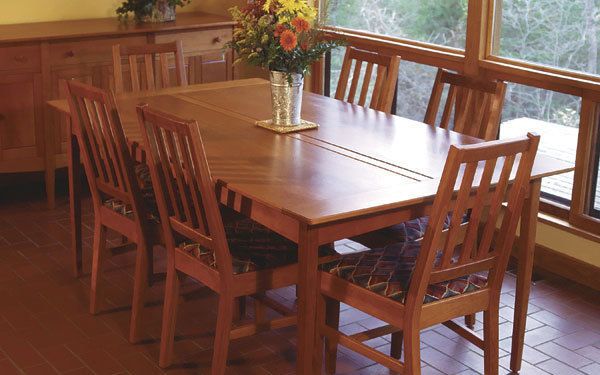Fresh Take on Tabletops
With a center gap for expansion, the design options multiply.

Synopsis: Doug Stowe has an innovative solution to the problem of wood movement on large, solid-wood tabletops. While using the traditional breadboard ends to keep the top flat and hide the end grain, he inserts a center gap — sometimes with decorative detail such as stones or other natural material — to absorb wood movement and to keep the breadboard ends flush with the rest of the top.
A few years ago, I attended a family reunion at a state park in Tennessee. As a woodworker, I couldn’t help noticing that the cabins in the park had solid-oak tables made with breadboard ends. The breadboard ends kept the tabletops flat and covered the end grain, giving a more refined look. I also noticed a common problem: The humidity had caused the top to expand so that it extended 3⁄8 in. on both sides of the breadboards.
Breadboard ends have an annoying design quirk related to humidity and wood movement. As humidity changes, a board expands and contracts in width. That same humidity, however, has no significant effect on the board’s length. And that’s the problem. When a table is built, the edges of the top often are made flush with the ends of the breadboards. During summer, when humidity is high, the top absorbs moisture and gets wider, but the breadboard ends stay the same length. As a result, some of the top’s end-grain begins to show. In the winter, when humidity is low, especially in heated homes, the top gets narrower as it dries and the breadboard ends stick out.
Center gap solves a problem
At the same reunion, an aunt, wanting to encourage my woodworking career, asked me to design and build her a table. With the cabin tabletop issue fresh in my mind, I began to consider other ways to address the challenges presented by the expansion and contraction of wood.
Inspired to think outside the box, I decided to make the top with a narrow center board separated slightly from the other boards to create a pair of end-to-end gaps. With the top attached to the breadboards only at the outside ends, the gaps allow the wood to expand and contract at the center of the table. That means the overall width of the top doesn’t change, and the edges of the top and the ends of the breadboards stay perfectly flush. The center board added a unique and interesting look to the table.
Since then, I’ve used a center-gap concept in several tables and even a bench. In some, I inlaid small, flat stones to add texture and visual interest.
From Fine Woodworking #187
For the full article, download the PDF below:
Fine Woodworking Recommended Products

Estwing Dead-Blow Mallet

Starrett 12-in. combination square

Bessey EKH Trigger Clamps








Log in or create an account to post a comment.
Sign up Log in